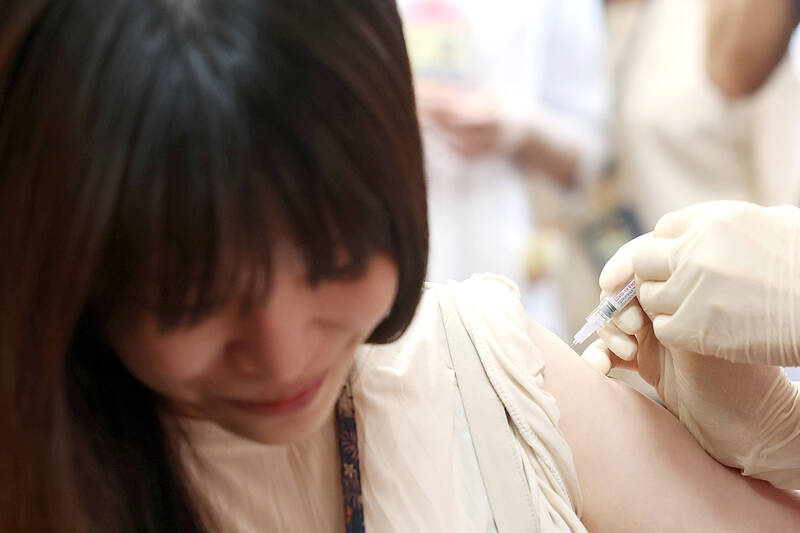Starting Oct. 1, 10 groups, including pregnant women, elderly people and healthcare workers, would be eligible for free COVID-19 vaccinations, the Centers for Disease Control (CDC) said yesterday.
The CDC said that its Advisory Committee on Immunization Practices determined earlier this month target recipients for the fall and winter vaccination program in line with the global trend that prioritizes high-risk populations over universal vaccination.
Eligible groups include people aged 65 and older, indigenous people aged 55 to 64, residents and staff at nursing homes and long-term care facilities, pregnant women, healthcare and disease prevention workers, childcare staff, and home-based caregivers and nannies.

Photo: CNA
Also included are parents of infants younger than six months old, children aged six months to six years old, and high-risk people aged six months and older — such as those eligible for flu vaccine priority, and people with tuberculosis, disabilities, mental health conditions or dementia.
Adults aged 50 to 64 without high-risk conditions would be eligible for free vaccinations in phase 2, which begins on Nov. 1, the CDC said.
At the committee’s meeting on June 12, the experts also recommended that the LP.8.1-targeted vaccine as the primary option, based on guidance from the WHO, the US and the EU, the CDC said.
Although COVID-19 variant NB.1.8.1 remains dominant domestically, the infections of variant LP.8.1 are increasing, it said.
Following the committee’s recommendation, the CDC plans to purchase 3.07 million vaccine doses ahead of the seasonal vaccination program, including 2.77 million doses of Moderna’s LP.8.1-targeted vaccine and 300,000 doses of Novavax’s JN.1-targeted vaccine for individuals who cannot receive mRNA vaccines, the CDC said.
The Moderna JN.1 vaccine currently in use would continue to be available to everyone aged six months and older until Sept. 30, it said.

TRAFFIC SAFETY RULES: A positive result in a drug test would result in a two-year license suspension for the driver and vehicle, and a fine of up to NT$180,000 The Ministry of Transportation and Communications is to authorize police to conduct roadside saliva tests by the end of the year to deter people from driving while under the influence of narcotics, it said yesterday. The ministry last month unveiled a draft of amended regulations governing traffic safety rules and penalties, which included provisions empowering police to conduct mandatory saliva tests on drivers. While currently rules authorize police to use oral fluid testing kits for signs of drug use, they do not establish penalties for noncompliance or operating procedures for officers to follow, the ministry said. The proposed changes to the regulations require

The Executive Yuan yesterday announced that registration for a one-time universal NT$10,000 cash handout to help people in Taiwan survive US tariffs and inflation would start on Nov. 5, with payouts available as early as Nov. 12. Who is eligible for the handout? Registered Taiwanese nationals are eligible, including those born in Taiwan before April 30 next year with a birth certificate. Non-registered nationals with residence permits, foreign permanent residents and foreign spouses of Taiwanese citizens with residence permits also qualify for the handouts. For people who meet the eligibility requirements, but passed away between yesterday and April 30 next year, surviving family members

China Airlines Ltd (CAL) yesterday morning joined SkyTeam’s Aviation Challenge for the fourth time, operating a demonstration flight for “net zero carbon emissions” from Taiwan Taoyuan International Airport to Bangkok. The flight used sustainable aviation fuel (SAF) at a ratio of up to 40 percent, the highest proportion CAL has achieved to date, the nation’s largest carrier said. Since April, SAF has become available to Taiwanese international carriers at Taipei International Airport (Songshan airport), Kaohsiung International Airport and Taoyuan airport. In previous challenges, CAL operated “net zero carbon emission flights” to Singapore and Japan. At a ceremony at Taoyuan airport, China Airlines chief sustainability

‘ONE CHINA’: A statement that Berlin decides its own China policy did not seem to sit well with Beijing, which offered only one meeting with the German official German Minister for Foreign Affairs Johann Wadephul’s trip to China has been canceled, a spokesperson for his ministry said yesterday, amid rising tensions between the two nations, including over Taiwan. Wadephul had planned to address Chinese curbs on rare earths during his visit, but his comments about Berlin deciding on the “design” of its “one China” policy ahead of the trip appear to have rankled China. Asked about Wadephul’s comments, Chinese Ministry of Foreign Affairs spokesman Guo Jiakun (郭嘉昆) said the “one China principle” has “no room for any self-definition.” In the interview published on Thursday, Wadephul said he would urge China to